337 Search Results for communication boards
August 26, 2019
by Carole Zangari -
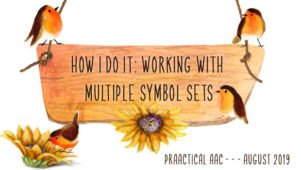
Amanda Samperi is back with the second post in her series about getting ready to return to school-based AAC services. Amanda is an AAC SLP who has worked in a variety of service delivery settings and runs the blog, AAC is Where It’s AT. Currently, she provides push-in language therapy to children with complex communication needs at a substantially-separate center school in Florida. She also conducts AAC/AT evaluations, provides year-round parent trainings, and assists the SLP team in instructing teachers/staff about communication supports and strategies In today’s post, she addresses a situation faced by many AAC teams: Serving children who use a variety of different AAC symbols and systems. If you missed Amanda’s initial post on back-to-school AAC, you can catch up on that here. ::::::::::::::::::::::::::::::::::::::::::::::::::::::::::::::::::::::::::::::::::::::::: How I Do It: Working with Multiple Symbol Sets It’s the beginning of the year – desks are in their spots, students’ names are... [Read More...]
July 25, 2019
by Carole Zangari -
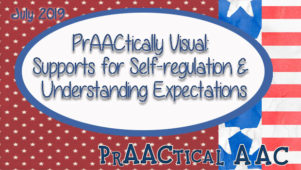
Looking to up your game in creating and using visual supports in your AAC work? Sit tight because the post below has plenty of information and downloadable files to help you out. Today, AAC SLP Tabi Jones-Wohleber is back to continue her series, this time focusing on supports for self-regulation and comprehending expectations for different situations. Tabi has worked in schools and early intervention supporting families, professionals, and individuals with AAC needs in West Virginia and Maryland. Tabi’s prAACtical approach to supporting AAC professionals has enriched the work of many of our readers. If you missed the initial segments in the series, you can get those here. Part 1 Part 2 Visual and Environmental Supports for Self-regulation & Understanding Expectations I hold the position that all behavior is communication. Attending to what an individual is attempting to communicate through behavior provides insight into why the behavior is occurring. And to... [Read More...]
July 18, 2019
by Carole Zangari -
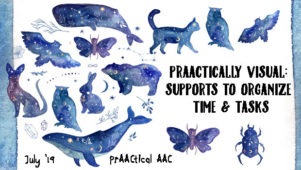
We’re glad you’ve returned for Part 2 of Tabi Jones-Wohleber’s series on Visual Supports. As an AAC specialist, Tabi uses these with children who have complex communication needs and teaches others to incorporate them as well. Let’s learn some of the ways in which visual supports can be used to help with organization, transitions, and independence. You can click on the images in the Downloadable Templates section to obtain the visual support files. If you’re interested in seeing more of Tabi’s work, you can check out Part 1 of the series here. ::::::::::::::::::::::::::::::::::::::::::::::::::::::::::::::::::::::::::::::::::::::::::: Visual and Environmental Supports to Organize Time and Tasks “But he knows his schedule” isn’t the whole picture. We all use schedules to help us manage our time and keep us on track when non-routine activities occur. For instance, you may know your schedule for any given Tuesday, but what about that Tuesday when you have... [Read More...]
July 11, 2019
by Carole Zangari -

We’re very excited to welcome back AAC SLP Tabi Jones-Wohleber to these pages. You may remember Tabi from the wonderful AAC training materials she shared (11 full modules) or used her Classroom CORE book. Maybe you downloaded her All-In-One Visual Support Tool, used some of her great suggestions about AAC therapy with young children, or were lucky enough to attend one of her conference presentations. Her expertise, generosity, clear command of AAC practices, and commitment to ethical service provision have enriched the AAC lives many of our readers. Today, Tabi launches a new 6-part series on one of our favorite topics: Visual Supports. Let’s get started! :::::::::::::::::::::::::::::::::::::::::::::::::::::::::::::::::::::::::::::::::::::::::::::::::::::::::::::::::::::::::::: Visual and Environmental Supports…4 – 3 – 2 – 1! Visual and environmental supports are the bread-and-butter of many a classroom with students with complex communication (and learning) needs. They may be presented on paper-based or electronic platforms. Understanding the purpose and process... [Read More...]
July 7, 2019
by Carole Zangari -
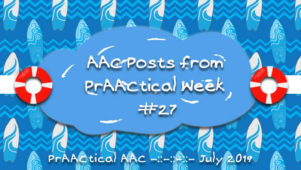
Happy Sunday, AAC friends! Here are a few posts from our busy week. Monday – How We Do It: The Talk Flock – Taking Care of Caregivers Tuesday – AAC Link Up Wednesday – Video of the Week: Unconventional Communication Thursday – Celebrating Independence Day with a Touch of AAC ::::::::::::::::::::::::::::::::::::::::::::::::::::::::::::::::::::: In the mood for some more AAC browsing? We have a few suggestions for you. 5 Ways to Support Self-Advocacy in AAC Learners How We Do It: Using AAC to Repair Communication Breakdowns PrAACtically SLPs: Hungry for Bilingual AAC 5 Kinds of Pre-stored Messages That Put the AAC Learner in Control PrAACtical Perspectives: Randomness & AAC
June 17, 2019
by Carole Zangari -
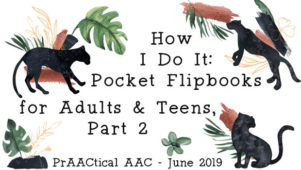
Grilling, wine tasting, horse racing…What did you talk about this weekend? The vocabulary and messaging needs of adults who have significant communication difficulties are often quite different than those of children and youth. Today, we welcome back SLP Katherine Dally who continues to share her experiences in creating and using small flipbooks for adults with complex communication needs. The flipbooks in this post (which can be downloaded via a link later in the article) focus on leisure activities that are perfect for summer. You can see Part 1 and download the template here. ::::::::::::::::::::::::::::::::::::::::::::::::::::::::::::::::::::::::::::::::: How To – Pocket Flip Book For Adults and Teens Have you worked with a client who was given a generic, low-tech paper communication board at the hospital? These are the boards that include pain, yes/no, and bathroom, among other basic needs and wants. With these boards, personalization is limited. The topics can be important, but... [Read More...]
May 30, 2019
by Carole Zangari -
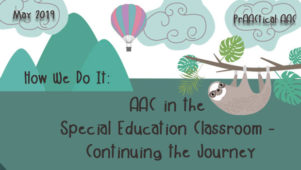
It’s such a pleasure to have Angi Pearce back on these pages to share her experiences and passion for teaching students with AAC needs. Angi is a teacher at Kowhai Special School in Hastings, New Zealand, and serves as the team leader for the Junior School classes (ages 5-11). Her initial post (see that here) introduced us to the ways that she embraced AAC and integrated it into her classroom. In today’s post, she talks about how things have evolved. Enjoy the journey! How We Do It: AAC in the Special Education Classroom – Continuing the Journey This is my fifth year teaching in a school for children with special needs. Five years ago, AAC was a new term for me. Core vocabulary boards were the first tools which were introduced to me, which I did not understand the benefit and purpose of until I observed the way it enhanced... [Read More...]
January 20, 2019
by Carole Zangari -
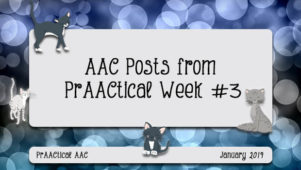
Well, hello, AAC friends! If you’re looking to catch up on some AAC content, you’re in the right place. Here’s what we’ve been up to. Monday – Core Boards in the Classroom: 3 Ways to Individualize to Meet Student Needs Tuesday – AAC Link Up Wednesday – Video of the Week: Language Development Across the School Day Thursday – PrAACtical Resources: Social Stories and Narratives :::::::::::::::::::::::::::::::::::::::::::::::::::::::::::::::: While you’re here, could you do us a favor? We’re trying to get input on AAC terminology from the people who use it most. Click here to complete a quick survey. It’s all multiple choice (checkboxes) and shouldn’t take more than a couple of minutes. No names or emails are collected. Thank you! :::::::::::::::::::::::::::::::::::::::::::::::::::::::::::::::: Still have an appetite for some AAC reading? These posts from the archives may be of interest. Reducing Prompt Dependence in AAC Learners: 5 Things to Try When Helping Isn’t Helping: Prompt Awareness... [Read More...]
October 22, 2018
by Carole Zangari -
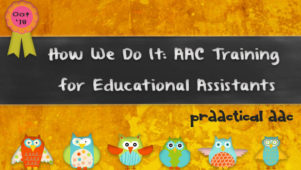
We’ve been focusing on training communication partners recently and today we’re focusing specifically on paraprofessionals/educational assistants. Our guest post is authored by SLPs Corinna Duffitt, M.Sc., RSLP (practicing for 21 years, 14 years in AAC) and Jennifer Wiegert, M.A., CCC-RSLP (practicing for 21 years, focusing on AAC for the past 6 years). They are colleagues on an AAC team with 4 other SLPs in a large school district in Surrey, BC, Canada. Their school district consists of 101 elementary schools and 20 secondary schools. Corinna and Jennifer are both passionate about giving children a voice and letting that voice uncovers their potential. They recently joined their private practice endeavours, outside of their public school positions, to form Chickadee AAC Communication Services. You can find them on Instagram (@chickadeeaacslps or #chickadeeaac), check in on their website, and/or follow them on Facebook. :::::::::::::::::::::::::::::::::::::::::::::::::::::::::::::::::::::::::::::::::::::::::::::::::::::::: AAC Training for Educational Assistants Some of the challenges we encountered... [Read More...]
October 1, 2018
by Carole Zangari -
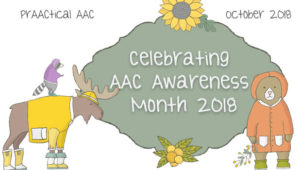
Let the celebrations begin! October is more than pumpkins and Halloween. It’s internationally recognized as AAC Awareness Month and it offers a wonderful opportunity for spreading the word as to how we can support people with complex communication needs. Looking for a few ideas that you can use in celebrating AAC Awareness Month? Here are a few to get you started. Light up your social media feeds with AAC Awareness messages. We’ve got some graphics to help you out. Here are some from previous years. You can also grab our 2018 Facebook banner here. Is Instagram your jam? We’ve got you covered. (Click on the image below to download.) Are you more of a Twitter fan? No worries. We’ve got something for you, too. (Click on the image below to download.) Make plans to attend ATIA 2019 for lots of AAC content. Early Bird conference registration closes on October 5 at 5 p.m.... [Read More...]









